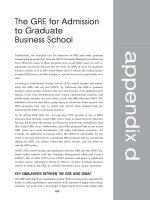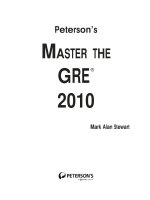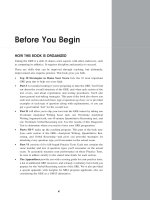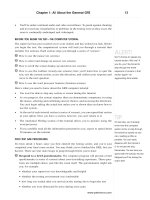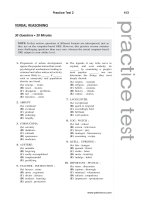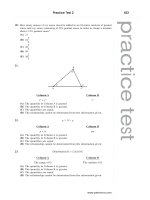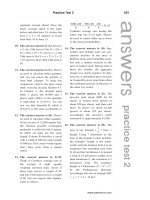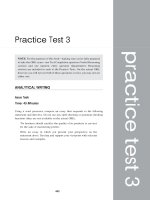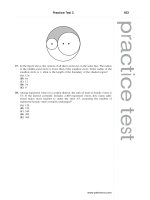Tài liệu Master the Gre 2010 - Part 59 docx
Bạn đang xem bản rút gọn của tài liệu. Xem và tải ngay bản đầy đủ của tài liệu tại đây (54.5 KB, 10 trang )
legitimacy to”—and so it is an apt
phrase for the first blank.
8. The correct answer is (D). This is
an “intrinsic aspect or quality”
analogy. COTTON is SOFT to the
touch; similarly, an iron is hard to
the touch. These are both inherent
tactile characteristics.
9. The correct answer is (E). This is
a “place or environment for” analogy.
FISH are kept in an AQUARIUM, an
environment created by humans.
Birds are kept in an aviary, also an
environment created by humans.
Lions live in dens, and insects live in
the ground, but these environments
are natural—they’re not human-
created. An automobile can be kept
in a garage, but an automobile has
no natural environment.
10. The correct answer is (C). This is
a “degree of” analogy. A SPARK is a
very small fire, while a CONFLA-
GRATION is a very large fire. The
relationship is one of degree. Simi-
larly, a drizzle is a very light rain,
while a downpour is very heavy rain.
11. The correct answer is (E). The
words “Just as” provide a clue that
Beethoven, like Mozart, was a
musical revolutionary. Therefore, to
say that he overturned the rules and
initiated change makes good sense.
12. The correct answer is (C). In the
second paragraph, the author states
that one of the effects of New Towns
was to draw high-income citizens
away from the cities—essentially
what choice (C) indicates.
13. The correct answer is (E).
According to the first sentence of the
passage, New Towns were originally
conceptualized as a way to absorb
growth. Based on other information
in the passage, it appears that New
Towns in the United States achieved
this objective—at least to some
extent—since city residents who
could afford to move away from
urban centers did so. At the same
time, however, the cities were left
with new problems, such as an insuf-
ficient tax base to support them-
selves and to retain businesses.
Thus, like a computer program that
attempts to solve one software
problem but creates another, New
Towns were a new innovation that
served to solve one problem but
created another along the way.
14. The correct answer is (B). To
SATIATE is to “fill to capacity.” To
deplete entirely is to use up com-
pletely. Crave (long for) is related to
satiate—a person who has become
satiated doesn’t crave anymore. But
lack of craving is not part of the defi-
nition of satiate.
15. The correct answer is (A).
OSSIFIED means “turned to bone, or
fossilized”; when wood, for example,
becomes fossilized, it hardens as
bone. Liquefied means “made or
turned to liquid.”
16. The correct answer is (D). REC-
TITUDE means “moral virtue or
strength.” Choice (D) provides an
ideal antonym.
17. The correct answer is (B). The
passage mentions exposure to sun-
light as one factor determining peak
bone mass. Although the passage
states that “many of the factors that
affect the attainment of peak bone
answers
practicetest6
Practice Test 6 563
.................................................................
..............................................................................................
www.petersons.com
mass also affect rates of bone loss,”
the passage does not indicate that
exposure to sunlight is one such
factor.
18. The correct answer is (A). The
author lists various factors affecting
peak bone mass, then asserts that
many of these factors also affect the
rate of bone loss. In mentioning preg-
nancy and lactation as “additional
factors” affecting bone loss, the
author implies that these two factors
do not affect peak bone mass.
19. The correct answer is (C). A mis-
creant is a villain, scoundrel, or
criminal. The sentence strongly sug-
gests that Catcher in the Rye might
provoke (incite) potential miscreants
to engage in violent antisocial
behavior.
20. The correct answer is (C). This is
a “defining characteristic” analogy.
An INTERLOPER seeks to MED-
DLE (interfere) in the affairs of
another. An advocate (ally) will
espouse (support or defend) a par-
ticular viewpoint or cause. In both
cases, the second word describes the
inherent objective of the first.
21. The correct answer is (A). This is
a “form of” analogy. To AMBLE is to
WALK unhurriedly without a prede-
termined destination. To tinker is to
work aimlessly without a predeter-
mined direction.
22. The correct answer is (B). This is
a “symptom of” analogy. One sign of
PARALYSIS is the lack of SEN-
SATION (feeling). Similarly, one sign
of dieting is the lack of obesity.Asfor
choices (A) and (E), the two words in
each pair are antonyms. The same
can’t be said for sensation and
paralysis. Paralysis is not defined by
a lack of sensation, but by lack of
ability to move.
23. The correct answer is (E). It is
reasonably inferable from the first
paragraph as a whole that the
“standard repertory” refers to the
music of Bach and Telemann as well
as to other (“modern”) music from
their time (first half of the eigh-
teenth century). In the second para-
graph, the author mentions that the
music of Bach, Telemann, and their
contemporaries called for obsolete
instruments. Thus, the standard
repertory might have included music
that called for the use of obsolete
instruments, as choice (E) indicates.
24. The correct answer is (D).
Although performance practice did
indeed involve varying the perfor-
mance of a work of music from one
time to the next (by including spon-
taneous vocal and instrumental
ornamentation), the passage neither
states nor implies that how the
delivery of music varied from time to
time depended upon the particular
tastes of the audience. Thus, choice
(D) is unsupported by the passage.
25. The correct answer is (A).
According to the passage, one reason
for the encroachment was that some
of the oral traditions associated with
the Viennese classics (the works of
Mozart, Haydn, and Beethoven)
could not be traced back to the eigh-
teenth century. Choice (A) supports
this point by providing specific evi-
dence that this was indeed the case.
26. The correct answer is (D). The
author’s primary concern in the
PART VI: Five Practice Tests564
.................................................................
..............................................................................................
www.petersons.com
passage is to trace the scope of works
included in performance practice
from the early twentieth century to
the latter half of the century. The
author identifies and explains the
reasons for the trend of including
later works within the scope of so-
called “early music” (second and
third paragraphs), then refers (in the
final paragraph) to a controversy
surrounding this trend. Choice (D)
reflects the author’s primary concern
as well as embracing the controversy.
27. The correct answer is (A). As a
whole, the sentence clearly suggests
that Martha wishes to emulate her
sister in order to accomplish at least
what her sister did. To attend a
“highly respected” college would
obviously require a good academic
record, so the first word must essen-
tially mean “excellent.” Choices (A),
(B), and (D) each provide such a
word. The word for the second blank
should relate to what’s needed to
achieve such a record. Among those
three choices, only choice (A) makes
sense.
28. The correct answer is (E). To
SYNERGIZE is to “coordinate dif-
ferent elements toward achieving a
common goal.” To sabotage is to
“deliberately spoil or damage as to
make useless or unproductive.” An
act of sabotage may very well be
designed to disrupt or spoil an
attempt to synergize. Though not a
perfect antonym, sabotage is the best
of the five choices.
29. The correct answer is (A). This is
a “defining characteristic” analogy. A
MUNIFICENT person is charac-
terized by great GENEROSITY;
similarly, a dolorous person is char-
acterized by great sorrow. Since luck
can be either bad or good, choice (D)
is not as strong an analogy as choice
(A).
30. The correct answer is (B). It’s fair
to characterize bullying as either
antisocial, cruel,oraggressive. The
word bravado means “pretense,” and
feigned means “pretended.” So by
pretending to be superior, a bully
hides his insecurities. Among the
choices, then, choice (B) makes for
the most cohesive sentence overall.
answers
practicetest6
Practice Test 6 565
.................................................................
..............................................................................................
www.petersons.com
Quantitative Reasoning
1. A
2. C
3. B
4. 16
5. D
6. B
7. D
8. C
9. D
10. A
11. E
12. C
13. B
14. C
15. E
16. B
17. C
18. D
19. A
20. B
21. E
22. D
23. C
24. C
25. A
26. D
27. C
28. D
1. The correct answer is (A). There
are six possible two-pair combina-
tions: (B1-B2), (B1-G1), (B1-G2),
(B2-G1), (B2-G2), (G1-G2). Since
four of the six combinations involve
removing one blue pair and one gray
pair, the probability is
4
6
,or
2
3
.
2. The correct answer is (C). In Quan-
tity A, divide by subtracting the de-
nominator exponent from the
numerator exponent:
x
x
xx
8
2
82 6
==
−()
.
In Quantity B, combine by adding ex-
ponents: (x)(x
2
)(x
3
)=x
(1+2+3)
= x
6
.You
can now see that Quantity A equals
Quantity B.
3. The correct answer is (B). Let
Jennifer’s salary equal 3x, and let
Carl’s salary equal 2x. A $200 raise
for Carl will bring his salary to 2x +
200. Thus, 3x =2x + 200, and x =
200. Therefore, Jennifer’s current
weekly salary is (3)($200) = $600.
4. The correct answer is 16. Divide
by 2 four times, as follows:
5 years ago: 256 4 2 = 128
10 years ago: 128 4 2=64
15 years ago: 64 4 2=32
20 years ago: 32 4 2=16
5. The correct answer is (D). The
total number of degrees is 360°, and
so x + x +2x +(x + 40) = 360. Solve
for x:
5 40 360
5 320
64
x
x
x
+=
=
=
6. The correct answer is (B). To
make the comparison, apply prime
factorization:
99=33 33=33 3 3 11
39=33 13
As you can see, the greatest prime
factor of 99 is 11, and the greatest
prime factor of 39 is 13. Therefore,
Quantity B . Quantity A.
7. The correct answer is (D). The
problem does not provide the actual
weight of any of the three horses,
and so it is impossible to make the
comparison.
8. The correct answer is (C). The
price of 100 apples (4 bags of 25) is
$28 (4 3 $7), the same as the price
for 100 pears. In other words, the
price of apples is the same as the
price of pears. Accordingly, to
compare the two quantities you can
simply compare the total numbers of
fruit pieces. You can see that the
totals are the same: 178 + 461.
Hence, the two quantities are equal.
PART VI: Five Practice Tests566
.................................................................
..............................................................................................
www.petersons.com
9. The correct answer is (D). The
minimum value of Quantity A is 1 +
2+3=6,inwhichcase qr = 6, and
the two quantities are equal. The
maximum value of Quantity A is 2 +
3+4=9,inwhichcase qr = 12, and
the two quantities are unequal.
Therefore, the correct answer is
choice (D).
10. The correct answer is (A). For
each year, the gray portion of the bar
indicates sales of oral injection medi-
cation. In 1991, those sales clearly
totaled more than $1 million, but in
1992 they totaled no more than $1
million.
11. The correct answer is (E). Since
the two areas both equal L 3 W, the
master bedroom (the longer room)
must have a length of
3
2
L and a
width of
2
3
W. Accordingly, the
perimeter of the master bedroom =
(2)
S
3
2
L
D
+2
S
2
3
W
D
,or3L+
4
3
W.
12. The correct answer is (C). A quick
way to divide by 500 is to first divide
by 1,000, and then multiply the quo-
tient by 2. In this problem, then,
divide 40.5 by 1,000 by simply
shifting the decimal point 3 places to
the left, and then multiply that quo-
tient by 2. The calculation is very
simple:
(.0405)(2) = .0810
13. The correct answer is (B).
Quantity A = 30 4 1.5 = 20; Quantity
B=(20)(1.5)=30
14. The correct answer is (C). Here’s
the sequence up to the 12th second:
0W
1B
2W
3G
4W
5R
6W
7B
8W
9G
10 W
11 R
12 W
Every time you reach a time divisible
by 6, the sequence starts over with
W and proceeds: W-B-W-G-W-R. 204
is divisible by 6; hence, starting at
the 204th second, here are the light’s
movements through the 209th
second:
204 W 205 B 206 W
207 G 208 W 209 R
As you can see, the movement from
the 208th to the 209th second is from
white (W) to red (R).
15. The correct answer is (E). You can
express the amount of sugar after
you add water as .05(60 + x), where
.05=5%and(60+x) represents the
total amount of solution after you
add the additional water.
16. The correct answer is (B). Multi-
plying together any combination of
the factors of p will result in a
product that is also a factor of p. The
only number among the choices
listed that is not a product of any of
these combinations is 36.
17. The correct answer is (C). Apply
the defined operation to the values
specified in each column:
Quantity A =
21
12
3
3
1
−−
−−
=
−
=−
()
Quantity B =
−−
−−
=
−
=−
24
42
6
6
1
()
18. The correct answer is (D). You can
express y
2
+ y 2 6 as the product of
binomials (y +3)and(y 2 2). Thus,
answers
practicetest6
Practice Test 6 567
.................................................................
..............................................................................................
www.petersons.com
